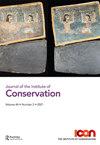Preliminary study into the reduction and removal of naturally aged varnishes from painted surfaces using an Er:YAG laser in a two-step cleaning process with solvents
IF 1
0 HUMANITIES, MULTIDISCIPLINARY
引用次数: 2
Abstract
Abstract A preliminary study into the reduction and removal of naturally aged varnishes, aimed at collating observations to encourage further study of the cleaning of paintings with intractable, difficult to remove coatings, is presented in this article. Er:YAG laser cleaning trials with dry laser exposures followed by solvent removal of natural resin varnishes were conducted on a naturally aged test panel, and an expendable nineteenth-century oil painting. Surfaces were examined with normal and ultraviolet light, a headband magnifier, and low-power digital microscopy, videography and colorimetry. Standard solvent cleaning tests were first carried out, followed by a two-step cleaning protocol where Er:YAG irradiation of the coating was followed by solvent cleaning, the laser being used to promote a weakening or disaggregation of the topmost portion of the layer or layers of varnish. The aim was to assess the laser cleaning outcomes conservators might expect on ‘real’ as well as mocked-up surfaces; results are presented from one of each. Cleaned areas of paint were also directly exposed to Er:YAG irradiation to determine a safe fluence with observations limited to relatively low magnifications. Overall these efforts inform the risks and contribute to the development and the safe use of this novel cleaning method.Er:YAG激光在溶剂两步清洗过程中减少和去除油漆表面自然老化清漆的初步研究
摘要本文对自然老化清漆的减少和去除进行了初步研究,旨在整理观察结果,以鼓励进一步研究难处理、难以去除涂层的油漆的清洁。在自然老化的试板和一幅19世纪的油画上进行了Er:YAG激光清洁试验,先用干激光照射,然后用溶剂去除天然树脂清漆。用普通光和紫外线、头带放大镜、低功率数字显微镜、摄像和比色法对表面进行检查。首先进行标准溶剂清洁试验,然后进行两步清洁方案,其中涂层的Er:YAG照射之后进行溶剂清洁,激光用于促进清漆层的最顶部的弱化或分解。其目的是评估保育员在“真实”和模拟表面上可能期望的激光清洁结果;每种方法的结果各有一个。油漆的清洁区域也直接暴露于Er:YAG辐射,以确定安全通量,观察仅限于相对较低的放大率。总的来说,这些努力告知了风险,并有助于开发和安全使用这种新型清洁方法。
本文章由计算机程序翻译,如有差异,请以英文原文为准。
求助全文
约1分钟内获得全文
求助全文
来源期刊

Journal of the Institute of Conservation
HUMANITIES, MULTIDISCIPLINARY-
CiteScore
1.50
自引率
0.00%
发文量
22
期刊介绍:
The Journal of the Institute of Conservation is the peer reviewed publication of the Institute of Conservation (Icon). As such, its aims reflect those of Icon, to advance knowledge and education in conservation and achieve the long term preservation and conservation of moveable and immoveable cultural heritage. The Journal provides a collective identity for conservators; it promotes and supports both the profession and professionalism. With international contributions on all aspects of conservation, it is an invaluable resource for the heritage sector. The specific aims of the Journal are to: 1. promote research, knowledge and understanding of cultural heritage conservation through its history, practice and theory 2. provide an international forum to enable and disseminate advances in research, knowledge and understanding relating to conservation and heritage 3. champion and support professional standards of heritage conservation in the UK and internationally 4. provide a permanent record of issues relating to conservation and heritage 5. be financially and operationally sustainable. To achieve these aims, the Journal invites contributions from all those involved in the conservation of cultural heritage and related activities. Areas of interest include understanding cultural heritage materials and their degradation; subject reviews and histories of cultural heritage materials and conservation treatments; new, innovative or improved approaches to conservation and collections care theory, practice, communication, management and training; case studies demonstrating new, innovative or improved approaches; and conservation in its wider context. Submitters are encouraged to demonstrate how their work is of practical application to conservation. To maintain professional standards and promote academic rigour, submissions of articles and shorter notices are subject to an anonymous peer review process.
 求助内容:
求助内容: 应助结果提醒方式:
应助结果提醒方式:


